MINOR ANTIQUITIES
(continued)
FABRICS
The yucca plant, which grows wild in the canyons and
level places of the Mesa Verde, furnishes a tough fiber which the
prehistoric people of Spruce-tree House used in the manufacture of
various fabrics. Small packages of this fiber and cords made of the same
material were found in the refuse-heap and in the houses these were
apparently obtained by heating and chewing the leaves, after which the
fiber was drawn out into cords or braided into strings.

FIG. 21. Belt.
|
A braided cord was also found attached to the handles
of jars, and this fiber was a favorite one in mending pottery. It was
almost universally employed in weaving cloth netting and other fabrics,
where it was combined with cotton fiber. Belts (fig. 21) or head bands
(figs. 22, 23) show the best examples of this weaving. Native cotton
fiber is not as common as yucca, being more difficult apparently to
procure. There is some doubt regarding the cultivation of the cotton
plant, and no cotton seeds were identified; the cloth woven from this
fiber shows great skill in weaving.
The bark of willows and alders was utilized for
fabrics, but this furnished material for basketry rather than for cloth.
One of the most beautiful specimens of woven cloth
yet obtained in the Mesa Verde ruins was taken from room 11; this is
apparently a headband for carrying bundles.
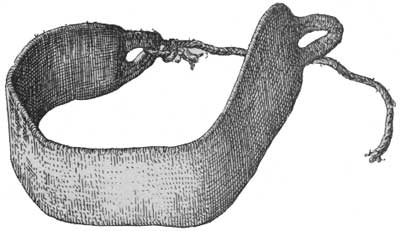
FIG. 22. Headband.
|
Among the objects obtained in the northern
refuse-heap were rings made of the leaf and fiber of yucca and other
plants, sometimes blackened as if by fire (fig. 24). These rings may
have been used for carrying jars on the head, although some are too
large and flat for that purpose. It has been suggested that the largest
were used in some game, but this theory lacks confirmation.
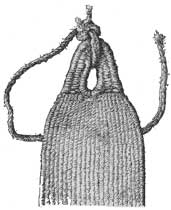
FIG. 23. End of headband
|
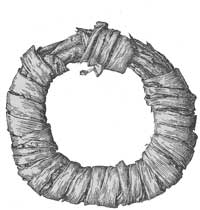
FIG. 24. Head ring.
|
Small fragments of matting were found, but no
complete specimen came to light. These fragments resemble those referred
to by Nord enskiöld as "objects used in carpeting the floors." It
was customary among some of the sedentary Indians of the Southwest to
sleep on rectangular mats, and in one building of compound B of Casa
Grande impressions of these mats were found on the floor.
Fragments of cloth made of yucca fiber (fig. 25), in
which feathers are woven, are abundant in the refuse heaps of
Spruce-tree House. There were found also many strings in which feathers
were woven (fig. 26), but of these nothing but the midribs remain.

FIG. 25. Yucca-fiber cloth with attached
feathers.
|
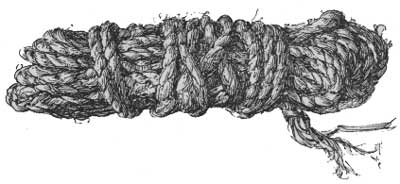
FIG. 26. Woven cord.
|
The object shown in figure 27 is made of agave fiber
tied in a series of loops. Its use is unknown.
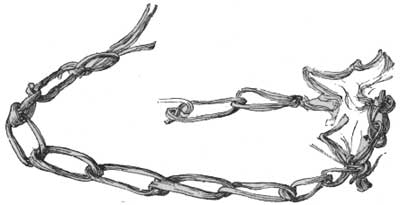
FIG. 27. Agave fiber tied in loops.
|
Several sandals were excavated at Spruce-tree House,
the majority from the refuse-heap in the rear of the dwellings. One of
these specimens, figure 28, is in good condition; it is evidently a
mortuary object, being found near a skeleton. The other specimen (fig.
29) is fragmentary, consisting of a sole of a sandal with attached toe
cords.
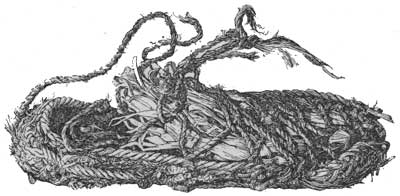
FIG. 28. Woven moccasin.
|

FIG. 29. Fragment of sandal.
|
Several specimens of slender yucca leaves bound in a
bundle were found. One of these (fig. 30) served as a hair-brush, or was
used in stirring food. One brush made of finer material was collected.

FIG. 30. Hair-brush.
|


